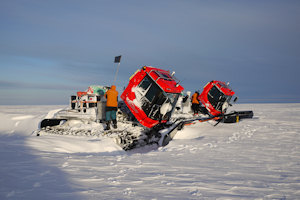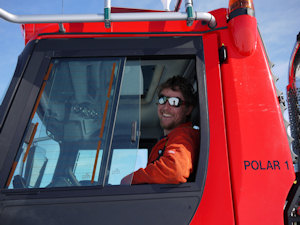Jonny Yates is an experienced Antarctic vehicle mechanic and operator. He will be returning to Antarctica to take part in the 2013-14 iSTAR traverse. Jonny will spend almost 4 months camping on ice; his journey will begin before most of the iSTAR scientists have even left their homes, and finish several weeks after they return. This interview was conducted in July 2013.
How did you first get involved in the iSTAR project?
I first went to Antarctica in 2008, as a vehicle mechanic at the British Antarctic Survey’s Rothera Research Station. I lived there for 18 months, including through the winter when there were just 22 of us. I loved it and was keen to explore other parts of the continent so when I heard they were looking for mechanics for the iSTAR project, I jumped at the chance.
I was part of the team that delivered the iSTAR vehicles, fuel and living accommodation to West Antarctica on board RRS Ernest Shackleton in early 2012. That was the very beginning of iSTAR.
Describe a typical day’s routine on the iSTAR
Well, it will depend on whether it’s a science day or a travelling day. We plan to move camp about every third day. On travelling days I’ll be up early to prepare and start the vehicles. On science days I’ll being doing any repairs and maintenance that’s needed and helping out the scientists if they need a willing helper.
When it comes to dinner time, we’ll all be taking turns as chef. The food we’ll be eating is basically army rations, so there won’t be a lot of variety and no fresh fruit or vegetables.
What preparations are you currently busy with?
I’m currently working in the garage at the British Antarctic Survey headquarters in Cambridge preparing some of the sledges and pulling equipment for iSTAR. I’ve just been working on a sledge that we can use to move one of the Piston Bullies (the big tracked vehicles used for iSTAR) if we don’t need them both to be pulling loads. Travelling with just one Piston Bully driving saves fuel. I have also built an A-frame for pulling two big fuel bladders behind a Piston Bully.
You’ve been worked in the iSTAR area of Antarctica before, what makes you want to go back?
Last time there were just 4 of us preparing the logistics, this time it will be a team of 12 and all about the science. I am really keen to get involved in the science. That’s the point of iSTAR after all!
What are you least looking forward to about the coming field season
There’s one job I’m really not looking forward to because I just know it’s going to be a bit of a pain to do out there in temperatures well below zero, that’s changing the windscreen on one of the machines.
Other than that, this year there will be so many of us in the team that we will be living in tents rather than in the cosy living accommodation we used last time. That will take a little bit of getting used to!
What are you most looking forward to about the coming field season?
As I mentioned before, I am really keen to see the science in action.
The terrain in West Antarctica is fairly monotonous. Do you get bored driving for hours across the flat white?
No, I love driving. How can you get bored driving a 450 horse power vehicle towing up to 40 tonnes?!
Normally we drive at 12.5 km per hour, although the machines have a maximum speed of 18 km/hour.
Of course we put music on, and sometimes sing along (I happen to have heard Jonny’s singing, he was in the band when I was at Rothera with him, and thankfully for his companions he’s pretty good) or we just have a good old natter.
What do you expect the main challenges of this year’s iSTAR traverse to be?
It might be tricky at times living with so many people in such close confines. We will all smell as bad as each other though!
Tell me a story about a challenge you had to overcome on your iSTAR journey so far…
The hardest thing so far was finding a site to land the ship and offload the vehicles and other cargo onto the ice. After a long journey to reach the remote West Antarctic coast, we spent a week breaking ice to try to reach a potential site that had been identified by a team travelling on snowmobiles overland. When we eventually got there, it was just too dangerous to unload such heavy equipment onto relatively thin sea ice. We set off again and were lucky enough to find that ice that had prevented us from getting to an area we had aimed at first had blown away so we found a great site where we could moor the ship to the ice shelf. This made the unloading much safer and, although hard, stressful work, it went well.


